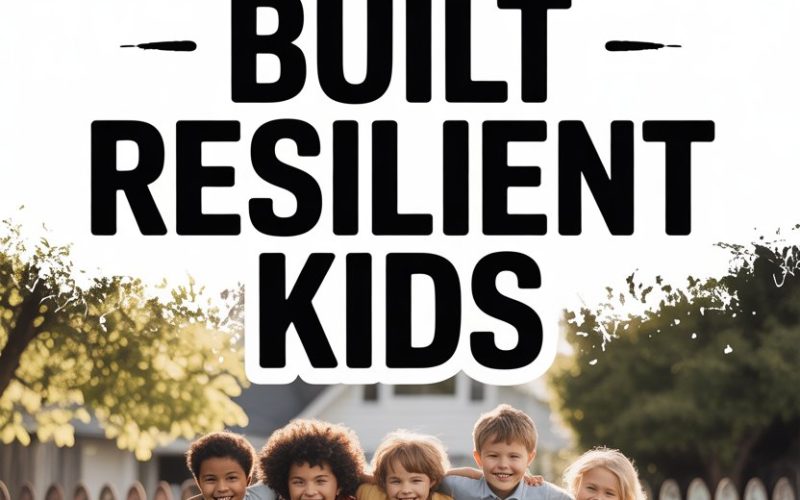Blink and there goes another TikTok trend, another missed soccer sign-up, another Amazon box full of things you didn’t realise you needed.
Modern parenting is a marathon in roller skates.
But if you’re old enough to recall slap bracelets, Goosebumps books, and that unforgettable dial-up screech, you might remember an era when “resilience” wasn’t a buzzword. It was just called “life.”
So how did 90s parents raise kids who could bounce back from scraped knees and heartbreaks alike?
Letting Boredom Breathe
There was a time when boredom was not a crisis to be solved, but an opportunity in disguise.
No curated schedules or Pinterest boards bursting with craft ideas—just a long, lazy afternoon, your imagination, and the vague threat that if you complained, you’d be handed a mop.
Research from the University of Central Lancashire found that boredom actually sparks creativity in children, nudging them to invent, build, or even just daydream.
When entertainment isn’t spoon-fed, kids learn to discover what lights their fire.
Tonight, try a little nostalgia-fuelled magic: announce a “tech timeout” for an hour and see what your child dreams up. It might be a pillow fort, a sketchbook masterpiece, or a truly disastrous attempt at baking.
Either way, they’ll build grit—and maybe some memories worth retelling.
Saying No, and Meaning It
It’s not just about denying the toy aisle for the fifth time that week. 90s parents had a knack for drawing clear lines and sticking to them. The word “no” wasn’t up for negotiation, and somehow, those boundaries made us feel secure, not stifled.
Psychologists like Dr. Laura Markham argue that healthy boundaries are the backbone of emotional resilience.
Kids learn to manage disappointment, delay gratification, and—here’s the kicker—realise that they’ll survive not getting everything they want.
Tonight, if your little one begs for another biscuit or a later bedtime, channel your inner 90s parent. Keep it gentle, but firm.
Watch as they weather disappointment and gradually, quietly, become a little more resilient.
Letting Kids Fail, Then Letting Them Try Again
A scraped knee, a science fair disaster, a missed goal—90s parents weren’t so quick to cushion every fall.
Sure, there was a Band-Aid and a hug, but rarely a rescue mission. Failure wasn’t an emergency. It was an education.
Child development experts now recognise that experiencing low-stakes failure teaches problem-solving and perseverance.
According to Dr. Angela Duckworth, author of “Grit: The Power of Passion and Perseverance,” it’s the “showing up again” that matters most.
This week, resist the urge to swoop in when your child’s Lego tower collapses or their art project goes up in glue fumes. Offer empathy, not solutions.
Suggest they have another go. The lesson isn’t about the tower, but the trying.
Trusting Kids with Real Responsibility
Chores weren’t called “life skills” back then. They were just Tuesday.
Mowing lawns, walking to the shops, looking after younger siblings—90s parents believed that kids could handle a surprising amount of responsibility.
Research from the Harvard Grant Study found that regular chores in childhood are a strong predictor of adult success. Responsibility breeds competence, and competence breeds confidence.
Consider adding a new, age-appropriate responsibility to your child’s routine. Watering plants, packing their own school bag, helping with dinner—anything that says, “I believe you can do this.”
Children rise to expectations, especially when those expectations aren’t sugar-coated.
Giving Space to Settle Conflicts
Sibling squabbles and playground spats were considered part of growing up, not a crisis that demanded adult refereeing. Unless blood was drawn (or a cherished vase was at risk), 90s parents often stood back and let kids figure it out.
Dr. Ross Greene, author and clinical child psychologist, points out that conflict resolution skills are learned through practice, not lectures.
When children navigate everyday disagreements, they learn negotiation, empathy, and—every parent’s dream—how to apologise.
Resist the urge to step in at every raised voice or pouting match. Stand by, give them the tools (“use your words”), and watch as they hammer out their own solutions.
You might be surprised at their resourcefulness (and your own newfound peace and quiet).
Normalising “Big Feelings”
Tears, tantrums, and adolescent angst weren’t whisked away with endless reassurance. While 90s parents weren’t always masters of the warm-and-fuzzy chat, they did teach kids to sit with their feelings rather than rush to fix them.
Current research from Yale’s Center for Emotional Intelligence suggests that emotional resilience blossoms when kids are allowed to feel their feelings—the good, the bad, and the ugly.
When your child’s day unravels, try validating their feelings instead of distracting or dismissing them. “Looks like you’re really frustrated about your game,” can be more powerful than “It’s not a big deal.”
Kids who are allowed to feel, learn that feelings pass. And that’s resilience, pure and simple.
Encouraging Unsupervised Play
Backyard cricket, unsupervised bike rides, and spontaneous games of manhunt—90s kids ran wild (within reason) and returned at dusk, sunburnt and exhilarated.
The American Academy of Pediatrics has since confirmed that unstructured, child-led play fosters independence, risk assessment, and resilience.
When every moment isn’t micro-managed, kids learn to solve problems, invent new rules, and support each other.
Start small: allow your child to play outside with minimal supervision while you’re nearby, or let them organise a game without adult input. A little breathing room can lead to big leaps in self-reliance.
Celebrating Effort, Not Just Results
Participation medals weren’t a given, and not every art project earned a spot on the fridge. Praise was offered, but it often came with a side of “keep trying” or “you worked really hard.”
Carol Dweck’s seminal work on growth mindset backs this up: praising effort and persistence helps kids see failure as part of learning—not a personal flaw.
Switch up your next round of encouragement. Instead of “You’re so smart,” try “I noticed how hard you worked on that puzzle.” It’s a small shift, but over time it turns setbacks into stepping stones.
Modelling Self-Sufficiency
Parents in the 90s weren’t perfect, but they showed kids what it looked like to muddle through, improvise, and handle life’s curveballs.
Dinner burnt? “We’ll have cereal.” School forms misplaced? “Guess you’ll have to ask for another.”
Self-sufficiency was modelled in everyday life, not just preached. When children see grown-ups coping (even awkwardly), they learn that perfection isn’t the goal—resilience is.
Let your children witness your own problem-solving moments. Narrate your thinking aloud when stuck in traffic or facing a minor setback.
Those little glimpses into “real life” are lessons they’ll carry well beyond childhood.
Everyone Survived Without Wi-Fi
Yes, this is mostly tongue-in-cheek—but there’s a grain of truth. Constant digital connection means kids rarely face boredom, awkwardness, or the need to wait.
The 90s taught patience: waiting for dial-up, for mixtapes to record, or for your turn on the family computer.
A study published in Child Development found that kids who engage in activities without constant digital stimulation show greater emotion regulation and adaptability.
Try a family “offline hour.” Read, draw, play a game, or just stare at the ceiling (it’s more meditative than you’d think). Crank up some 90s tunes if you like. The magic isn’t just in what you do—it’s in learning that waiting isn’t the enemy.
Why Resilience Still Matters
Life isn’t getting any simpler. The skills 90s parents handed down—often unwittingly—are just as crucial today.
Boredom, boundaries, failure, responsibility, messy feelings, courageous play, unpolished problem-solving, and a healthy respect for the power of “no” all add up to kids who can weather storms and find their way.
Try sprinkling a bit of 90s grit into your nightly routine. Resist the urge to fix everything, entertain every moment, or shield from every bump in the road.
Children are wired for resilience; modern parenting just needs to give them a little room to prove it.
Now, if you’ll excuse me, my Tamagotchi needs feeding.





